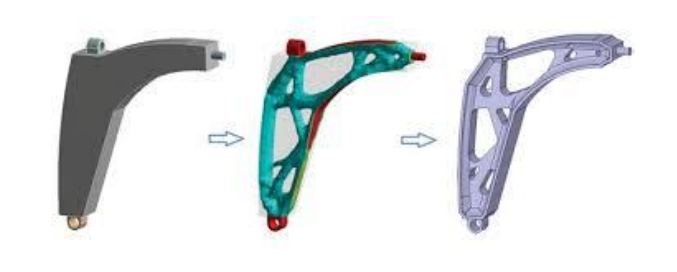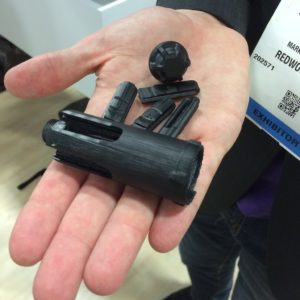Launcher succesfully test-fires EOS 3D printed copper rocket engine
Metalworking in the US: Will 3D Printing Play a Larger Role?
 As 3D printing makes an entrance into most industries today within the US and around the rest of the world too, we see this versatile and extremely progressive technology offering many different benefits. Whether being used in the medical or veterinary fields for items like protheses and implants, industries like aerospace where rockets now bear 3D printed parts, or architecture where prototypes are quickly created and refined over and over, researchers, engineers, and designers are able to create new parts and objects that were not previously possible.
As 3D printing makes an entrance into most industries today within the US and around the rest of the world too, we see this versatile and extremely progressive technology offering many different benefits. Whether being used in the medical or veterinary fields for items like protheses and implants, industries like aerospace where rockets now bear 3D printed parts, or architecture where prototypes are quickly created and refined over and over, researchers, engineers, and designers are able to create new parts and objects that were not previously possible.
Industries such as construction are embracing 3D printing in myriad ways too, along with other subcategories such as metalworking. While overall, the construction and building industry may be using 3D printing expansively, for a niche like metalworking (namely, in steel), prototyping is where it’s at—for now. Masters students at MIT, Aline Blanche Grynbaum Ingberman and Sittipat Assavaniwej, recently published a thesis centered around supply chain management. In ‘3D Printing’s Impact on the Metalworking Industry,’ the authors explore current trends in use of the technology, along with current and project obstacles.
Metalworking has of course seen many transformations throughout the ages, but the need for raw material and having it close by has not changed:
“In most cases, one will find steel manufacturers closer to the raw materials than to the consumers. For steel, the primary raw material is iron ore, which is now produced at several sites around the world. Close proximity to suppliers not only ensures a reliable source, but also significantly reduces time and transportation costs,” state the researchers in their paper.
Along with supply management, there are challenges in the workforce as so much of the younger generation endeavors to gain four-year degrees, eschewing trade professions such as metalworking—much of which may be considered old fashioned careers. As time progresses, this may change as the use of materials and technology become more updated due to the use of additive processes rather than subtractive ones.
The authors collected their data by visiting sites using CNC production processes and 3D printing, interviewing owners, operators, and managers, and performing other research such as the use of a detailed survey that yielded 133 responses. In line with the main topic for their study, the researchers focused on both small and larger businesses, questioning the potential for comprehensive 3D printing practices in the future:
“For large business, a surprising 29% of respondents say that, at some point, they are considering replacing 100% of the production process with AM. For small business, 9% says that too,” stated the authors in their paper. “Given the high initial investment cost, one possible explanation for this are businesses that were born dependent of 3DP. One example is a company that was visited for the project, that manufactures 3D printed prosthesis for hips and knees. Since the beginning, their process was 100% based on AM.”
While the researchers predict prototyping will still be the main use for 3D printing in metalworking processes over the next three to five years, they examined the benefits for its use within the industry overall:
- Shorter value chain
- Less material waste
- Latitude in designing and making changes quickly
- Speed
- Savings on the bottom line
Companies such as PTooling (Canada), GE (worldwide), and MTU (Munich) are currently involved in using 3D printing to make strides in manufacturing of aerospace components.
“With AM you can spread out the load and lighten the part. For example, the wing’s leading-edge formers can be redesigned to be wider to accomplish stability while weighing less,” said Marvin Fiebig, owner of PTooling.
“We’re not going to blow the doors off standard machines–I wouldn’t want to do that–but if we can give a customer a newly designed component that meets their needs in four weeks instead of 20, they will probably opt for using the new technology. Basically, we can make a part that is 30 percent lighter, 50 percent stronger, produce it faster, and material costs will be cheaper because we’re not machining away the biggest portion of a material block.”
And while it is possible that 3D printing may eventually eclipse CNC processes, there are still hurdles such as lack of necessary variety in metals, cost of materials, and some issues with quality, post-processing procedures, and the necessary means for fabricating larger parts.
“3D printing is a promising emergent technology. Like most new technologies, 3D printing still needs to evolve before it can be widely adopted by the metal working industry. While it is already viewed as a viable and useful technology, AM still has barriers to overcome,” concluded the authors. “Currently, the main barriers for most business are the high initial investment required and the limitation of materials available for 3DP. Limited printable size also is a main concern regarding AM adoption, independent of the industry segment and business size.”
What do you think of this news? Let us know your thoughts! Join the discussion of this and other 3D printing topics at 3DPrintBoard.com.
[Source / Images: DSpace@MIT]
Interview: Brook Drum is Back. The Demise of Printrbot and Brook’s Next Steps
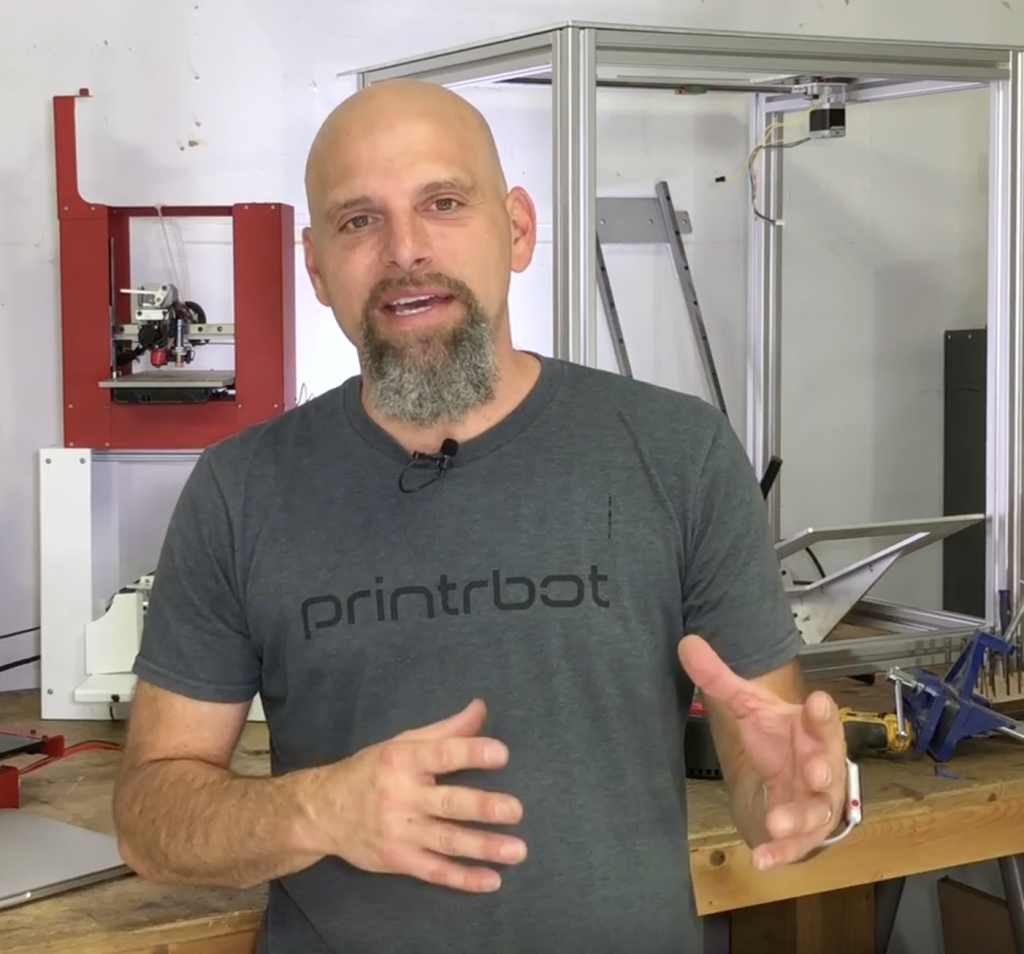
I loved Printrbot. The company made value engineered, tough, hackable, well designed and well made 3D printers. Where everyone else was just a clone army, Printrbot made inexpensive 3D printers that worked. It was a company with a lot of integrity and honesty. Printrbot was also one of the most successful 3D printing companies ever selling over 50,000 systems. The Printrbot Metal and Simple designs were widely copied and the open source 3D printer company never really took in much per printer. Average sales prices were low and printers were sold for around $500. There were machines that I could heartily recommend though and with some tweaking they worked really well. There was real quality and integrity present in how the company operated and in the product itself. Brook was also inspiring in the quixotic path he took and the great 3D printer designs that he created. He just wanted to make a good cheap printer that anyone could use, a noble cause. Sub $300 3D printer competition cost the company dearly however and in a sudden shock, it went under. The clone army had claimed a victim. Brook took some time to regroup and now he’s back. In this open-hearted interview 3DPrint.com talks to Brook about what happened with Printrbot and what is next for a personal 3D printing hero of mine. He’s now on Patreon and looking to educate and make content for the 3D printing community. You can support him here.
How are you doing?
“Ha! For a CEO that had to shut down his once wildly successful company and file for bankruptcy… I’m good! I know that will sound harsh to many, but few of your readers will be able to personally relate to the situation I am living. I’m glad that is the case! All things considered, though, I have a lot to be thankful for! So, yeah, I’m good.”
What’s it like to go out of business? Did you feel it emotionally also?
“It has been an incredibly lonely time. Brutal. Just agonizingly brutal.
Sadly, this last year, I walked alongside one of my best friends, Dan, as he slowly lost his fight with pancreatic cancer. We saw signs, had time to prepare, were so happy to savor every moment… but in the end, it was awful. Awful. Just a few weeks before I closed Printrbot, I performed Dan’s funeral and graveside service and put my friend in the ground. I miss him, dearly.
Printrbot’s death was NOTHING like that… but it was kinda like that. It hurt. It broke my heart. It was very, very painful. But I was so blessed to even have it! I so enjoyed my time with Printrbot. I am a better man because of it, no question. I now have the clearest picture I have ever had of myself — who I am as a person and what is important in life. My faith in God, my family, & my friends. Losing a business is hard, but people are way more important. Period.”
I interviewed Scott Crump once and he said that the best advice is to stand up one more time than you fall down?
“Good advice. I like to say: “I get knocked down, but I get up again. You’re never gonna keep me down.”
If any wisdom can really come from a band called “Chumbawamba“.
Your reference to Scott Crump’s quote is really addressing the human condition, not business. No matter what, just dust yourself off and get back on that horse. Try again. And by the way, stop whining about it! That’s life.”
Did low-cost Printers kill your business?
“One of my chief mantras in life is “OWN IT”. That means, if you screwed up, just say so. Admit fault and move on. There are always other factors in the environment but own your decisions and consequences. That said, Printrbot failed as a direct result of my decisions along the way. Anything beyond that description is not the main cause. But, yes, cheap Chinese-made printers, AND Amazon.com selling them, AND Americans choosing to buy them – it all contributed significantly to Printrbot’s demise.”
Why didn’t you turn to the community for aid? You’ve done so much for them?
“750 thousand reasons. Er, dollars. Yeah, it wasn’t something the community could or even should help with. It was math. The desktop 3D printing community votes with their dollars. In 2011, they voted BIG for me and Printrbot. But things changed. The market became crowded. The hype resulted in disappointment for many. Even being a “Maker” has changed somewhat. In some respects, the promise of a printer in every home rings hollow. Whatever the case, buyers went elsewhere. But the way I ran my company resulted in financial failure – and thats on me, not them.
I actually did try to find a buyer for the company. I would have taken 1 million for it and paid off the debt just to avoid losing everything. But right now is just a really bad time to sell a 3D printer company.
I have asked myself if not telling the public was a pride thing. But I don’t really think so. I was optimistic, right up to the end, that I could cut costs to the bone and survive. It actually took me by surprise. I never watched Printrbot’s bank account. I checked it maybe once a year. Weird, huh. Next thing I know, I am in my lawyers office with my wife and my CFO talking about bankruptcy. It was very sudden.”
Why are you continuing with supporting Printrbot customers?
“I am a people person. I treated my customers as family. Sometimes, I had to deal with my crazy uncle, but you still love the guy. Most of the time, dealing with the Printrbot family was all hugs and warm fuzzies. I truly loved my customers. I owe then so much.
But, let me be clear. I don’t feel obligated to do anything for anyone. I have lost more, financially, than any customer… so even if I wanted to offer a refund or send a free this or that… its just not possible. There is no money to give. We went bankrupt. But I am a helpful guy and love 3d printing, so if I can help someone with information, I will! I don’t feel I have to, I want to.”
Were you tempted to leave 3D Printing behind?
“No. I love it and know it is an incredible tool for so many applications. I have more I want to do and create in this space. But if I can’t find a sustainable niche AND perform well in that market… I may have to turn to another market for business. It’s not that CEOs choose to leave 3D printing behind, its that 3D printing has left many CEOs behind.”
What are your ambitions now?
“Youtube + Patreon.com/brookdrumm
It may take a while, but I want to grow my audience on YouTube and work to have that content provide enough income to make more. Thus the Patreon thing. People contribute monthly to allow me to do this. I like to think of it as the “Value for Value” model. I’ll produce good stuff that has value and some will choose to give back value. Its a beautiful thing. Some of the content will be 3d printer related, but I have lots of things on the list. Its going to be fun to give a project the time it deserves! I am also starting a long-form audio podcast. I will tell my story on the first episode, but my next two guests are Bre Pettis (of Makerbot fame) and Max Lobovsky (FormLabs). This alone is worth signing up for my Patreon channel!”
Will you make more 3D Printers?
“Yes, of course. It is who I am now.
Right now, I am helping Carl Ubis, of ubishotends.com, carry the torch and provide accessories to serve customers. But I do plan to design and make new printers at a much smaller scale. Printrbot was drifting into building larger and larger printers, so I am having fun exploring that niche. Currently, I am building a few “Model 3” printers for a prosthetic non-profit Niatech.org. This printer design has outperformed the competition in the wild, costs far less and, frankly, I am way easier to work with than some companies. (Me talking, not them) This large format work is inspiring me to keep designing and building. As people have need or desire, Carl and I are happy to accommodate. Its not only fun to solve new problems, but the prices of large format printers on the market make me so mad. They should not cost $10000, $20000. It’s ridiculous.”
I’m a lifer. I mean I’m never going to do anything else other than 3D Printing. You?
“Long term… well,
, I have been dreaming for years about starting a company that makes open source electric motors and controllers for electric car conversions. So I am going to try and do that. I have already found the team that can make this happen and all have agreed to get on board. The 65kW motor design is almost done – designed by a very talented specialist on the team. But I need to raise funds to finish making the prototype motors and install them in one of my cars to prove it is real. Then we will take it to Kickstarter and see if there is a market for it. One thing is for sure – this company will be debt free. Period. Yes, it all sounds crazy, but thats where I like to live. If people aren’t telling you you’re crazy, you aren’t dreaming big enough. This one is a moonshot thing for me. It may take a while, but its going to be great!”
What advice do you have for people making 3D Printers?
“To hobbyists:
Building your own kit should be about fun, learning, a challenge, exploration, innovation. It is straight forward and achievable. Buy wisely, not cheaply. And consider that this hobby is about leisure, interest or the people with which you do it. In fact, I would challenge everyone to regularly pursue the hobby WITH PEOPLE. Go out and do something meaningful with your cool tools and new found knowledge. It is meant to be shared.
To Designers:
1. Stop making ugly printers. They don’t have to be ugly. But if you do, admit that you simply chose function and threw form out the window. For me, products that people spend hard earned money on should be beautiful. Its way harder to make a functional machine beautiful. Do that and you will stand out.
2. Know WHY you are designing that particular machine. The world doesn’t need more 3D printers. It needs BETTER ones. How is your design better than what already exists? Test the heck out of your designs and if its not better than whats already out there – throw it in the trash. What is the point? Different isn’t better. Better is better. Cheaper is most definitely not better. Better is still better. Aspire to make quality, reliable, indestructible, value packed, easy to use machines.
To companies making crappy printers:
stop it.”
What lessons have you learned?
“So. Many. Lessons.
#1. Work smarter, not harder.
I poured too much of myself into Printrbot. I don’t think it was healthy. Not for me, not for my family, not for anyone. I am not going to make that mistake again. I should have worked smarter, not harder. I should have sought out advice from others who have gone through the hardware startup process before making some of the crazy decisions I made early on. I sometimes tried to do crazy things just because I knew I could. We almost always pulled it off, but it was way too hard. I made it hard.
#2. Seek contentment. Money doesn’t make you happy. Period.
I always wanted to be a CEO of a fast-growing company. I wanted to be a millionaire by 40. Be careful what you ask for. It sounds cliche, but maybe a better way to say it is: if you can’t find contentment right where you are, right now, you won’t find it in that green grass on the other side of the fence.
#3. Do what you love.
I really did love what I got to do at printrbot. Loved it. But guess what.. I can still do it in my garage or in some other small business I start. I love making stuff. I will never stop. And you can’t make me. I wouldn’t stop if you paid me to. I love it.
Now go find something you love and do that thing.”
Subscribe to his YouTube channel here. You can support Brook and get early access to his podcast and videos on Patreon.
Printrbot 3D printer founder Brook Drumm to return with new company
BigRep and Bosch Rexroth partner to develop smart factory 3D printing systems
3D Printing Mega Man – Bakery Assembly Process ENGAGE (w/ Chaos Coretech)
A Closer Look at 3D Printing Support Structures
Support structures are a necessary evil of 3D printing. They can be frustrating and time-consuming, but they are required to keep many parts from collapsing or becoming distorted. In a paper entitled “Support Structures for Additive Manufacturing: A Review,” a group of researchers take a close look at supports and their various forms and functions, and evaluate some of the research that has been conducted on them already.
The purposes of support structures, according to the researchers, can be divided into three types:
- Supports that act as a heat diffuser and rigidity enhancer, preventing shape distortion and residual stresses due to excess heat accumulation, particularly in metal 3D printing
- Supports that are necessary in processes like FDM so that material isn’t being deposited in midair
- Supports that act as a tether to keep parts from shifting and/or collapsing
Support structures, while necessary, also have plenty of disadvantages, including creating excess material that often cannot be reused, as well as creating lots of extra work to remove. They also result in longer print time and additional work and expertise required to generate them properly. The paper discusses how to circumvent some of these obstacles, including optimizing the orientation of the part and the structure of the supports, as well as using sacrificial or soluble supports or support baths.
In the study, the researchers take a look at other publications that have been dedicated to 3D printing support structures, and find that the majority of them are focused on FDM 3D printing, rather than metal 3D printing processes.
“The reason for this is most probably because of the unavoidable and higher requirement of support in FDM, and the popularity of the printing technique,” the researchers state. “FDM needs material beneath the printed layer as it is extrusion-based, while for powder processes, the powder could take the role of support. In addition, the unused powder which acts as the support can be reused, to an extent, in the future. However, the supports fabricated in extrusion-based processes are generally unable to be reused, unless the supports are re-manufactured into filaments. For powder bed processes, the support material is generally for ameliorating against thermal stresses during manufacture and to anchor the printed part within the build volume.”
Many of the studies reported focus on the optimization of part orientation in order to minimize support usage, but others are dedicated to eliminating support usage altogether. One research team tried to use an inclined deposition method for FDM, but the method is a bit complex and involves control over the direction of the nozzle. Another proposal involved using water or ice as supports for SLA builds.
“Though this strategy seems to eliminate using the part material as support, it instead requires the repeated heating and cooling of water to induce the necessary phase change, which may be less energy efficient,” the researchers point out.
 The design of support structures should be based on several principles. The support should be able to prevent the part from collapsing or warping, especially the outer contour area; for metal processes, stress and strain need to be considered and thermal simulation modeling can be considered for design. The connection between the supports and the final part should be the minimal strength needed, in order for removal to be as easy as possible, and the contact area between the support and final part should be as small as possible to minimize damage. Material consumption and build time should also be considered.
The design of support structures should be based on several principles. The support should be able to prevent the part from collapsing or warping, especially the outer contour area; for metal processes, stress and strain need to be considered and thermal simulation modeling can be considered for design. The connection between the supports and the final part should be the minimal strength needed, in order for removal to be as easy as possible, and the contact area between the support and final part should be as small as possible to minimize damage. Material consumption and build time should also be considered.
Support structures are unavoidable in many 3D printing processes, the researchers conclude, but more effort should be made to minimize the negative effects of supports. In the research that they evaluated, there were a few gaps that they pointed out, including the lack of a comprehensive method for reducing support material while keeping the mechanical strength and surface finish quality.
“In addition, some innovative and creative methods which can largely minimize or even achieve zero-support for AM are urgently necessary,” the researchers conclude. “Support structure modeling needs to be adopted in the future, especially for metal processes. Further, a standardized model and uniform criteria need to be made in the future for fairly comparing different support methods and choosing the most economical strategy. Lastly, topology optimization is necessary to be integrated into support structures for further reducing materials used, making AM a more sustainable technology.”
Authors of the paper include Jingchao Jiang, Xun Xu, and Jonathan Stringer.
Discuss this and other 3D printing topics at 3DPrintBoard.com or share your thoughts below.
3D Printing News Briefs: September 29, 2018
We’ve got some 3D printing event news to share with you in today’s 3D Printing News Briefs, along with some business news and a story about a cool 3D printed container. At the TCT Show this week, Additive Industries announced a partnership with Laser Lines, and DEVELOP3D Magazine will soon celebrate product design and metal 3D printing at a live event. CRP Technology has created an updated 3D printed fairing for the Energica Ego Corsa superbike, and employees at the GE Additive Customer Experience Center in Munich made a 3D printed beer krug just in time for Oktoberest.
Additive Industries Partnering with Laser Lines
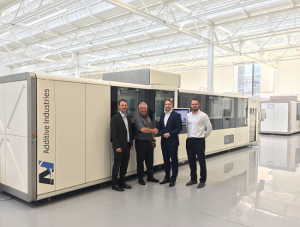
L-R: Mark Beard, General Manager UK, Additive Industries; Mark Tyrtania, Sales Director, Laser Lines; Daan Kersten, CEO, Additive Industries; and Phil Craxford, Sales Manager, Laser Lines
At the opening of the TCT Show, which took place in Birmingham earlier this week, Additive Industries announced a new partnership with Laser Lines Ltd. in order to speed up its 3D printing presence in the UK and Ireland. Laser Lines is a UK supplier of 3D printers, 3D scanning equipment, lasers, and related accessories, and will work together with Additive Industries to help grow the maturing market in the UK and Ireland for industrial 3D printers. Laser Lines will support Additive Industries in its work to further develop the industrial market for various applications in the aerospace, automotive, machine building, and medical sectors.
“With the recently announced expansion to the UK with a dedicated Process & Application Development Centre, we already acknowledge that the UK & Ireland is an important market that provides great opportunities for industrial companies to enter into industrial metal additive manufacturing,” said Daan Kersten, the CEO of Additive Industries. “With Laser Lines Ltd we add an experienced partner to our fast growing worldwide network that will work with us to identify and manage these opportunities that will contribute to our execution of our accelerated growth.”
DEVELOP3D Magazine Holding Live Event
 Each year, DEVELOP3D, a monthly print and digital design journal, holds a live US event all about product design. This year’s DEVELOP3D Live event will be held this coming Tuesday, October 2nd, from 8 am – 6:30 pm at Boston University.
Each year, DEVELOP3D, a monthly print and digital design journal, holds a live US event all about product design. This year’s DEVELOP3D Live event will be held this coming Tuesday, October 2nd, from 8 am – 6:30 pm at Boston University.
“We have some really fascinating folks coming to celebrate product design in the 21st Century,” Martyn Day from X3D Media, which runs DEVELOP3D, told 3DPrint.com. “We are especially pleased to have Ti Chang from Crave, Tatjana Dzambazova from new metals 3D printing company Velo3D and Olympian, Jon Owen from Team USA Luge.
“Our day is split with MainStage presentations from designers and the industry, together with a track dedicated to Additive Manufacturing, with all the latest in metals 3D printing.”
Tickets are just $50, and include full access to the conference and all 30 exhibitors, plus refreshments, lunch, and drinks at a social mixer. There will be 20 speakers presenting in two separate streams, and topics include CAD, topology optimization, 3D printing, virtual reality, and product development.
3D Printed Fairing for Ego Corsa
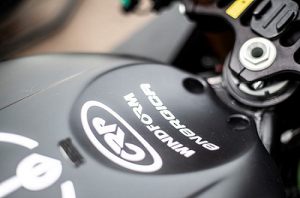 Together, Italy-based CRP Group and its subsidiary Energica have been using 3D printing and Windform materials to develop components for electric motorcycles and superbikes for a few years now. In April, the Ego Corsa electric motorcycle completed its third demo lap, and at the last series of road tests before the first edition of the FIM Enel MotoE World Cup, the 2019 2019 Ego Corsa prototype hit the track with a new 3D printed fairing, manufacturing by CRP Technology with its laser sintering technology and Windform XT 2.0 Carbon-fiber reinforced composite material. The 3D printed fairing update has improved the Ego Corsa’s aerodynamics.
Together, Italy-based CRP Group and its subsidiary Energica have been using 3D printing and Windform materials to develop components for electric motorcycles and superbikes for a few years now. In April, the Ego Corsa electric motorcycle completed its third demo lap, and at the last series of road tests before the first edition of the FIM Enel MotoE World Cup, the 2019 2019 Ego Corsa prototype hit the track with a new 3D printed fairing, manufacturing by CRP Technology with its laser sintering technology and Windform XT 2.0 Carbon-fiber reinforced composite material. The 3D printed fairing update has improved the Ego Corsa’s aerodynamics.
“We have had the fairing available in short time. Thanks to the professional 3D printing and CRP Technology’s Windform composite materials, it is possible to modify motorcycle components – even large ones – from one race to the next ones, in order to test different solutions directly on the track,” said the Energica technical staff.
“This fairing is not only more aerodynamic, but it also has a smaller frontal and lateral section. These improvements led to achieve increase in terms of performance and they led to achieve greater manageability in fast corners.
“The Windform XT 2.0 has once again proved to be a high performance composite material. We are very happy how the 3D printed new fairing behaved during the tests.”
GE Additive 3D Prints Metal Beer Stein
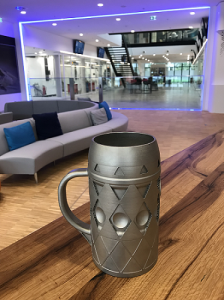 Even though the month of October doesn’t start for another few days, Oktoberfest itself officially kicked off last Saturday in Germany. In order to celebrate the occasion, the AddWorks team at the GE Additive Customer Experience Center in Munich, which opened last winter, decided to take another look at the traditional glass beer krug; what we’d call a pitcher or stein in the US.
Even though the month of October doesn’t start for another few days, Oktoberfest itself officially kicked off last Saturday in Germany. In order to celebrate the occasion, the AddWorks team at the GE Additive Customer Experience Center in Munich, which opened last winter, decided to take another look at the traditional glass beer krug; what we’d call a pitcher or stein in the US.
The unfortunate thing about glass is that it breaks. Obviously, if you’ve enjoyed too much beer at an event like Oktoberfest, the likelihood of breaking your glass drink container goes way up. So AddWorks decided to create a new prototype beer krug, but instead of using glass, they 3D printed it using a combination of stainless steel and titanium…and the result is pretty impressive.
Take a look at the video below, which stars the head of the Munich CEC (Matthew Beaumont), to see the whole process:
Discuss these stories and other 3D printing topics at 3DPrintBoard.com or share your thoughts in the Faceboook comments below.
2018 TCT Hall of Fame Inductees and 3D Printing Award Winners Announced
This year’s TCT Show, held in Birmingham as usual, ended earlier this week, and yielded many announcements about new 3D printing materials, software, and of course, 3D printers and their associated hardware. Additionally, the annual TCT Awards was held for the second time during a gala dinner at the Hilton Birmingham Metropole on Wednesday. British actor and presenter Robert Llewellyn hosted the nearly 300 guests at the awards, which celebrates, according to TCT Group owner Rapid News Publications Ltd, “the people, technology and collaborations behind the best in design-to-manufacturing innovation.”
There were 14 competitive award categories, and the TCT Awards recognized the partners in many collaborative projects, in addition to the designers, technology providers, and engineers. Three more 3D printing industry leaders were also inducted into the TCT Hall of Fame in honor of “their contribution to the industry and to the growth in technology adoption.”
“Once again it was a privilege to share an evening with so many truly exceptional people,” said Duncan Wood, Chief Executive of Rapid News. “All of the winners are to be congratulated for their successes, and of course in particular the Hall of Fame inductees need a special mention, their innovation, entrepreneurship and commitment has played a huge part in the development and success of the industry.
“I must also thank our sponsors 3ecruit, as well as our supporting partner, Innovate UK for their endorsement of the event and of course our judges. The TCT Awards night is fast becoming THE night of the year for the industry and we are looking forward to the 2019 edition already!”
The first of the new TCT Hall of Fame inductees is Dr. Carl Deckard, who invented and developed Selective Laser Sintering (SLS) 3D printing technology while based at the University of Texas. Together with his former professor Joe Beaman, Dr. Deckard co-founded DTM Corporation, which was later purchased by 3D Systems, to commercialize SLS 3D printing.
The second 2018 inductee into the TCT Hall of Fame is application specialist and process pioneer Greg Morris. In 1994 he founded Morris Technologies, a specialist AM services provider, which was purchased by GE Aviation in 2012, along with sister company Rapid Quality Manufacturing. His work in developing metal 3D printing applications and processes has increased their adoption in the aerospace and medical sectors, and he distributes his knowledge through his involvement in the speaking circuit.
Professor Emanuel ‘Ely’ Sachs, who invented binder jet printing at MIT in 1989, is this year’s final TCT Hall of Fame Inductee. Professor Sachs, who is on the leadership team of Desktop Metal and still teaches at MIT, actually coined the phrase ‘3D printing’ at that time, and binder jetting technology is a building block for much of the market’s current technology.
As for the rest of the TCT Awards, Project MELT, with its tech lead listed as BEEVERYCREATIVE, won this year’s Aerospace Application Award, while the winner of the Automotive Application Award was the BMW i8 roadster SLM bracket by tech lead SLM Solutions.
The Vitamix nozzle by Carbon won the Consumer Product Application Award, while the winner of the Creative Application Award was the Embrace jewelry collection by Cooksongold for Boltenstern. SPEE3D won the Hardware Award – Non Polymers for LightSPEE3D, and the Hardware Award – Polymers went to E3D for its Tool-Changer.
Axial3D won the Healthcare Application Award for the use of its pre-op planning model aids in a world-first surgery at Belfast City Hospital, and Trinckle 3D won the Industrial Product Application Award for its mass customization of copper inductors. The Materials Award – Non Polymer went to SABIC for its EXL AMHI240F 3D printing filament, and NanoSteel took the Materials Award – Polymers for its BLDRmetal L-40 steel 3D printing material.
3D Systems was the winner of the Metrology Award for its Aircraft Damage Assessment for Easyjet, and Steros GPA Innovate S.L. won the Post-Processing Award for its DLyte: Metal DryLyte Electropolishing. Materialise won the Software Award for its e-Stage Metal, and this year’s Rising Star Award was given to HiETA Technologies Ltd.
To learn more about the winning projects and companies, and see the Highly Commended projects, visit the TCT Awards website.
Discuss the TCT Awards and other 3D printing topics at 3DPrintBoard.com or share your thoughts in the comments below.



